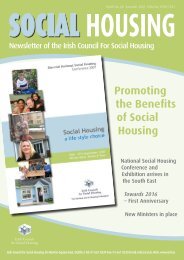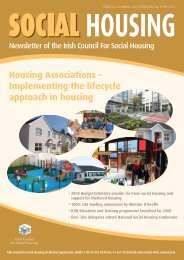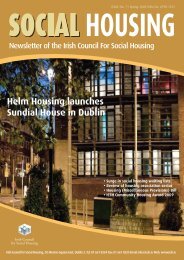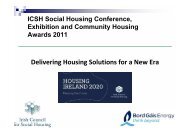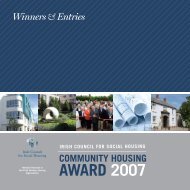National Housing Strategy for People with a Disability 2011 - 2016
National Housing Strategy for People with a Disability 2011 - 2016
National Housing Strategy for People with a Disability 2011 - 2016
Create successful ePaper yourself
Turn your PDF publications into a flip-book with our unique Google optimized e-Paper software.
During regular visits support staff carry out reviews <strong>with</strong> tenants to establish their currentneeds, prioritise them and develop action plans <strong>with</strong> the tenant to address them.An important aspect of this model is the maintenance of strong linkages <strong>with</strong> housingauthority staff, homeless services and local community mental health services. Thisenables tenants to link in <strong>with</strong> services as required to ensure their continuum of recoveryand, in some cases, facilitate the transition to more independent living. Links tocommunity education and employment initiatives are particularly important in this area.HAIL housing is located in the community, <strong>with</strong> general needs and privately ownedhousing, thereby avoiding ghettoisation and reducing the stigma associated <strong>with</strong> mentalhealth disabilities.<strong>Housing</strong> First Model9.45 A traditional model of housing <strong>for</strong> people progressing from intensive supportarrangements (such as hospitals) to independent living has been that they live <strong>for</strong> a time in“transitional” or “step-down” housing (supported housing but <strong>with</strong> less support than theintensive support of hospitals / in patient units). This model has been particularly used <strong>for</strong><strong>for</strong>merly homeless people. However, recent research 92 indicates that a “housing first”approach achieves better outcomes <strong>for</strong> people. Under this model a person is assigned longtermaccommodation and support is provided in this accommodation, <strong>with</strong> the supporttypically tapering out as the person becomes more accustomed to independent living. Itssuccess is based on the fact that the person is supported to live in the community which willbe their long term home, unlike transitional housing where a person learns to live semiindependentlyin one location and is then uprooted to live in a different location, dealing<strong>with</strong> the associated stress of moving and settling in again.(g) Homelessness and Mental Health Disabilities9.46 The current Government strategy on homelessness, The Way Home: A <strong>Strategy</strong> toAddress Adult Homelessness 2008 – 2013, recognises that a mental health disability is a riskfactor in becoming homeless and refers to the fact that mental health disabilities, and alsoaddiction problems, have a higher prevalence in the homeless population than in the generalpopulation. The Dublin Joint Homeless Forum, <strong>for</strong>mally the Homeless Agency, reports that aminimum of 24% of adults who are accessing homeless services have disclosed a diagnosed92For example, Edgar and Geertsema (2008) highlight the ‘rather positive results of the “<strong>Housing</strong> First” approachgaining much influence in the United States’; and refer also to ‘a tendency across Europe to move from placecentred approaches to person centred provision, i.e. from supported housing to support in housing.’ TheHomeless Agency evaluation of services 2008 also states “There is a growing literature, mainly from the USA,which asserts that the housing first approach leads to better outcomes than the traditional route.”120120



